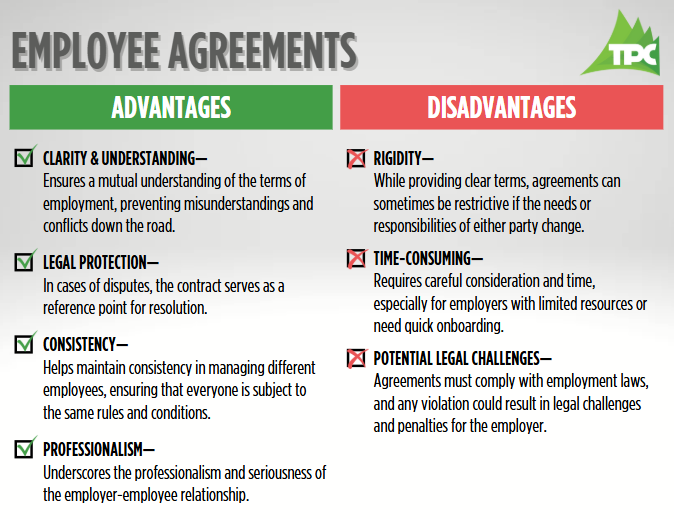Originally published 6/23/2022; updated 6/16/2025.
Onboarding is the cornerstone of helping new employees feel at home in a company. It’s the crucial first step that builds connections, establishes trust, and sets the stage for a successful career. Often referred to as organizational socialization, onboarding ensures new hires seamlessly integrate into the company’s culture while aligning with its mission and goals.
A key part of this process, now more vital than ever, is the employee agreement. This essential document not only formalizes the relationship but also lays the groundwork for clear expectations and mutual understanding. Let’s explore why this agreement plays such a pivotal role in effective onboarding.
What Are Employee Agreements?
An employee agreement is basically a contract between you and the new person joining your team, whether they're a regular employee, freelancer, independent contractor, or subcontractor. It sets the stage for your working relationship, clearly outlining everyone's roles. This helps keep things transparent and ensures everyone is on the same page, making the whole setup feel more secure.
An employment agreement can also be called the following terms:
- Offer letter
- Offer of employment
- Employment contract
- Contract of employment
- Employee contract
- Job contract
The standard employee contract covers various elements, such as:
Salary
This section of the employee contract will outline the agreed-upon salary, including wages and commission. It should also clarify any opportunities for advancement, potential raises, and how often performance evaluations will occur.
Benefits
This section covers all the benefits employees will receive, such as insurance plans, holidays, and vacation days. Everything should be clearly outlined in the contract. Understanding these benefits helps employees appreciate the full value of their employment package.
Work Responsibilities
This section specifies the job descriptions, including the employee’s title and what they’ll be responsible for in the company. Both you and the employee can discuss and negotiate these responsibilities to ensure everyone’s on the same page.
Employment Duration
This part of the document outlines how long the employment will last—whether it’s permanent, temporary, or on a contract basis. It helps both you and the employee set clear expectations and plan accordingly.
Schedule
This section covers the details about the employee’s work hours and days. This includes start and end times, daily and weekly hours, and the days they’re expected to work. It may also cover scheduling flexibility, overtime, and break policies to ensure everyone is clear on time commitments.
Termination Conditions
This part explains how and when employment can end, including the concept of at-will employment, where either the employer or employee can end the job at any time, with or without cause. It also covers notice periods, reasons for immediate termination, and conditions for leaving. Additionally, it outlines what needs to be done with company property, when the final paycheck will be issued, and how employee benefits will be handled. This ensures both sides understand the rules and steps if the job ends.
Other Important Terms in Employee Agreements
In addition to the standard elements of an employee contract, there are several other terms that companies often include to address specific needs and protect their interests. Some of these additional terms include:
- Confidentiality and Non-Disclosure
- Non-Compete
- Non-Solicitation
- Health and Safety Policies
- Company Property
- Remote Work Policies
Employers may choose to include these additional terms in the onboarding contract if they are relevant to their company. By doing so, they ensure clarity and protection for both the employer and the employee regarding these specific aspects of the working relationship.
Why are Employee Agreements Important?
Employee agreements play a key role in the onboarding process for several reasons:
- They clearly outline job expectations, ensuring both the employee and employer are on the same page.
- In cases of workplace uncertainty, these agreements, along with company guidelines, can provide clarity and help resolve issues, depending on how well they are written.
Types of Employee Agreements
Just as there are various types of employees and employers, not all employee agreements are created equal. They can be tailored to fit the unique needs of each company and employee. Some common types of employee agreements include:
Offer Agreements
- These agreements can begin as verbal offers (oral) and are often followed by a written offer in the form of an at-will employment agreement.
- They outline the basic terms of employment, such as job title, salary, and start date.
- In at-will states, even written offers typically state that employment can be terminated by either party at any time.
Confidentiality Agreement
- This agreement protects sensitive company information from being disclosed during or after employment.
- It may include trade secrets, client lists, business strategies, or proprietary data.
- Employees who violate a confidentiality agreement can face legal consequences, including damages or injunctions.
Non-Solicitation Agreement
- This contract prevents a former employee from soliciting clients, customers, or coworkers after leaving the company.
- It’s often used to protect business relationships and reduce the risk of losing clients to a departing employee.
- Enforceability can depend on the reasonableness of the time frame and geographic scope.
Non-Compete Agreement
- This agreement restricts an employee from working for a competitor or starting a similar business for a set period of time.
- Enforceability varies widely by state—some states, like California, largely prohibit non-competes.
- These contracts are more likely to be upheld for high-level positions or when proprietary knowledge is involved.
Remote Work Agreement
- This outlines the terms and expectations for employees working outside of a traditional office environment.
- It may cover work hours, communication standards, equipment use, and data security.
- This agreement helps set boundaries and ensures productivity while working remotely.
Advantages & Disadvantages of Employee Agreements
Bottom Line: Employee Agreements Are Essential
An employee agreement is a cornerstone of a successful onboarding process. It provides new hires with clear guidance, making it easier for them to settle into their roles while fostering a productive workplace. This document ensures clarity, legal protection, and consistency, laying the foundation for a strong employer-employee relationship from day one.
Crafting a thorough, tailored employee agreement is vital for addressing company needs and safeguarding interests. By making it a standard part of onboarding, businesses promote transparency and cultivate a positive, healthy work environment.




